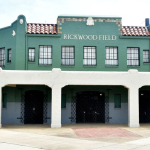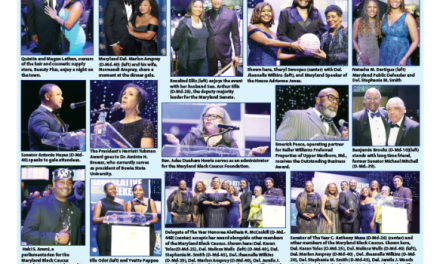By Bruce Markusen
National Baseball Hall of Fame and Museum
Negro Leagues baseball endured a serious decline in the 1950s and completely died out by the 1960s.
Given the passage of time – more than 55 years – it’s not surprising that few of the Negro Leagues ballparks remain in existence.
Of the ballparks that served as the primary home parks for Negro Leagues team, only five remain throughout the country. The short list includes Hamtramck Stadium in Hamtramck, Mich.; Hinchcliffe Stadium in Paterson, N.J.; J.P. Small Stadium in Jacksonville, Fla.; and League Park in Cleveland, Ohio.
There is just one other Negro Leagues park that remains standing– and it happens to be the oldest of the five. More remarkably, it is the oldest ballpark in the United States. Rickwood Field, located in Birmingham, Ala., continues to serve as a playing field for high school and college teams. First utilized as a Negro Leagues park in 1920, Rickwood dates all the way back to 1910, making it older than such venerable ballparks as Boston’s Fenway Park and Chicago’s Wrigley Field.
The ballpark will be in the national spotlight on June 20 when “MLB at Rickwood Field” takes place between the San Francisco Giants and St. Louis Cardinals.
Billed initially as “The Finest Minor League Ballpark Ever,” Rickwood Field became the first minor league ballpark constructed from concrete and steel. Modeled after Forbes Field, the home of the Pittsburgh Pirates, it played as a pitcher’s park, with initial dimensions that could best be described as canyonlike. With a distance of more than 500 feet to straightaway center field, 470 feet down the left field line, and 335 to right field, Rickwood proved extraordinarily difficult for home run hitters. Only left-handed power hitters with a tendency to pull could readily take advantage of Rickwood’s dimensions.
Expansive and stately (with its covered infield grandstand), Rickwood Field initially served as the home of the minor league Birmingham Barons. Like other ballparks of the era, the fences at Rickwood Field featured a variety of advertising. One sign promoted the Tutwiler Hotel, a place where some of the Barons players stayed. Another sign advertised Fatima Cigars, the favorite brand of the team’s owner and the builder of the ballpark, industrialist Rick Woodward. And along the left field line, a large, lettered sign reminded fans, “NO BETTING IN THIS PARK.”
In 1920, Rickwood Field took on a second tenant, the Birmingham Stars of the Negro Southern League, which operated as a minor league. The franchise was soon renamed the Birmingham Black Barons, who in 1924 earned the right to move up to the Negro National League, regarded as major league caliber.
Be A Part Of Something Greater
There are a few ways our supporters stay involved, from membership and mission support to golf and donor experiences. The greatest moments in baseball history can’t be preserved without your help. Join us today.
The Black Barons found their first true star in the form of Mule Suttles, a hard-hitting first baseman and outfielder. Rickwood Park’s dimensions kept Suttles’ home run totals low (only 13 home runs combined for the two seasons), but that didn’t stop him from hitting .318 and .331, respectively.
The mid-1920s brought improvements to Rickwood Field. The steel infield grandstand was extended to cover the right field bleachers, giving shade to more fans during the hot summer weather. And then in 1928, a Spanish mission-style façade was added to the park entrance, where picturesque arched openings and stucco walls welcomed fans to the games.
As a team, the Black Barons began to make their mark in 1927, winning the league’s second-half pennant on the strength of the pitching of a young Satchel Paige. The 20-year-old right-hander won seven of nine decisions, posted a 2.39 ERA and struck out nearly a batter per inning. Even though the renovations to the park made Rickwood Field somewhat more inviting to hitters, Paige and most of the other Black Barons pitchers still found Rickwood, with its lengthy distances to the outfield, most welcoming.
After a fourth consecutive dominant season in 1930, Paige left the confines of Rickwood, departing the Black Barons for a team known as the Cleveland Cubs. The Black Barons franchise soon fell back in status, demoted to the Negro Southern League. It was also during the mid-1930s that Rickwood Field added lights to its infrastructure. Four monumental steel-frame light towers were erected around the park, allowing for night games, a welcome addition in a city known for its heat and humidity.
In 1937, the Black Barons moved up again and became part of the Negro American League, where they struggled for the next few seasons. But they became competitive in the early 1940s, setting the stage for a league championship in 1943 and an appearance in the Colored World Series. Despite a lack of big name or headlining stars, the Black Barons pushed the favored Homestead Grays – a team that featured a “who’s who” of stars that included Josh Gibson, Buck Leonard, and Cool Papa Bell – to the brink before losing the Series, four games to three. The Black Barons would tack on another NAL title in 1944.
In 1948, the Black Barons added a player who would soon become an iconic figure. They signed a 17-year-old outfielder named Willie Mays, who was still in high school. Under an unusual arrangement, Mays played only at Rickwood Field and not in road games, presumably so that he could still attend school and play for the varsity team. Mays would appear in 17 games for Birmingham and bat just .233 while playing the outfield corners. That same year, Mays and the Black Barons advanced to the Colored World Series (being played for the final time), where they lost in five games to the powerhouse Homestead Grays.
Over the next three seasons, Mays emerged as a superstar. The large dimensions of Rickwood Field allowed him to show off his full arsenal of athleticism. With his quick jumps, blazing speed and remarkable range, Mays covered the Rickwood Field grass like no other outfielder in Black Barons history. Mays also drew the attention of several established major league teams, including the New York Giants, who signed him in June of 1950.
Changes In Ownership
From 1949 to 1956, the Black Barons endured three changes in ownership. As with most Negro Leagues teams, Birmingham’s attendance suffered, with fan interest declining because of the departure of quality players to the American and National League. With the departure of Mays and their popular shortstop/manager, Piper Davis, who left the team in 1950, the Black Barons had seen the last of their truly legendary players come through Rickwood Field.
In 1960, the Black Barons played their final game at Rickwood Field. Even with the Black Barons ceasing operations, Rickwood Field still had its original tenant in the form of the Birmingham Barons, a minor league franchise in the Southern Association since 1910. But Rickwood suddenly lost the minor league Barons after the 1961 season, for reasons directly related to race and segregation. In November of 1961, Major League Baseball mandated that all minor leagues would have to integrate by 1962, including the Southern Association. That league featured teams in Birmingham and New Orleans, where local laws continued to enforce Jim Crow segregation and did not allow Blacks and whites to play against each other on the same field.
Citizens who favored segregation pressured Barons owner Albert Belcher to fold the team instead of allowing Blacks to play for Birmingham. Belcher wanted to retain the team, but ultimately gave in to the local pressure and ceased operations. Without a Birmingham team, considered one of the league’s bellwether franchises, the Southern Association also collapsed.
“Checkers Rule”
In large part, Belcher was influenced by legislation that existed within the city of Birmingham. At the time, the city lived by an ordinance listed as Section 597, which was referred to as the “Checkers Rule.” This local law prevented Blacks and whites from participating in the same sporting contests. The ordinance stated, “It shall be unlawful for a Negro and a white person to play together or in company with each other in any game of cards, dice, dominoes, baseball, softball, football, basketball or similar games.”
This law covered every sport, and yes, it even included the game of checkers.
One of the most fervent proponents of the Checkers Rule was Theophilus “Bull” Connor, who happened to be the longtime public address announcer for the Birmingham Barons. In his fulltime job, Connor worked as the commissioner of public safety for Birmingham. The city’s government structure featured a three-man commission, of which Connor was one. That gave Connor plenty of power, including administrative control over the Birmingham Police Department.
Given his prominent role in city management, Connor oversaw the enforcement of the Checkers ordinance. He was also vehemently against the integration of baseball in Birmingham, so much so that he led an effort called “Keep Birmingham Baseball White.” As Larry Colton, the author of the acclaimed book, Southern League, told National Public Radio, Birmingham’s baseball history had always involved segregation, even with regard to the fans. “Basically [with] the white Barons, the white people went to see them,” said Colton. “And the Black Barons, the Black people went to see them. And they had a chicken wire fence that separated [white from Black]. If somebody from the opposite race went, they had to sit on the far side of the chicken wire fence.”
Bull Connor opposed integration at the ballpark – and in all aspects of Birmingham society. When civil rights activists known as the “Freedom Riders” came to Birmingham in 1961, Connor intentionally allowed them to be beaten by members of the Ku Klux Klan for a full 15 minutes without any help or intervention. Later on, in one of his final acts as commissioner, he directed policemen to use fire hoses and attack dogs against peaceful civil rights protesters.
Violent incidents like these proved so embarrassing for the city of Birmingham that voters changed the form of local government, eliminating the three-man commission, including Connor’s position. Birmingham adopted a new kind of government: it featured a mayor and a nine-man council. Connor then attempted to run for mayor, but lost the election. Even though the Checkers Rule would technically remain on the books for several more years, it would quickly become ignored and unenforced.
In the meantime, Albert Belcher wanted to see professional baseball restored to Birmingham. As the owner of the now defunct Barons, he had succumbed to the pressure of dissolving the team because of the Checkers Rule and local sentiment. But he was not a true opponent of integration – and saw the decline and fall of the Checkers Rule as an opportunity to restore baseball in Birmingham with a new Barons franchise in a newly proposed Southern League.
Belcher sought to own and operate the new team, but he faced stiff opposition, notably from the Ku Klux Klan. (In earlier years, the Klan had staged rallies at Rickwood Field.) Belcher received at least a dozen threats of violence over the phone. The callers all delivered a similar message: “If Blacks play at Rickwood Field, somebody’s gonna die.”
Even in the face of such threats of violence, Belcher remained steadfast. He also realized that he needed a major league owner to go along with the plan, someone who would be willing to put his minor league affiliate in a racially charged city, supply the team with players, and incur the expenses of running a franchise.
City’s First Integrated Team
Belcher found his man in Kansas City Athletics owner Charlie Finley, a native of the Birmingham area. Finley agreed to place the Athletics’ Double-A minor league affiliate at Rickwood Field. He would outfit the minor league Barons with green and gold uniforms, to reflect the colors of the parent Athletics. More importantly, he would supply the Barons with several Black players, including outfielder Tommie Reynolds and right-handed pitcher John “Blue Moon” Odom. The 1964 Barons would also include a few Black Latinos, notably shortstops Bert Campaneris and Ossie Chavarria.
With that, professional baseball, in the form of the city’s first integrated team, was re-born in Birmingham. And in a decision that epitomized the new integrated era of baseball, Belcher removed the chicken wire fence that had separated Black baseball fans from white fans.
In 1967, Finley renamed the franchise the A’s, keeping the team at Rickwood Field until 1975. Finley then pulled up stakes, leaving Birmingham without a franchise for the next five seasons. In 1981, the Detroit Tigers placed their Double-A franchise in Birmingham, restored the Barons nickname, and remained there until 1986, when the Chicago White Sox took over the operation of the team. The following year, the White Sox moved out of Rickwood and into a suburb of Birmingham known as Hoover. And then in 2013, the Sox returned to the city confines with the opening of Regions Field, which has remained the Barons’ home ever since.
While Rickwood no longer has a fulltime minor league occupant, it retains a connection to the legacy of professional baseball, including Black baseball. The ballpark, which still has a sizeable capacity of over 10,000, has been used as a backdrop for baseball scenes in three films: Cobb, Soul of the Game, and 42. Soul of the Game centers on three legendary players from the Negro Leagues (Satchel Paige, Josh Gibson, and Jackie Robinson) while 42 tells the story of Robinson’s first season with the Brooklyn Dodgers.
More than 110 years after it first opened, the ballpark’s legacy remains vital to the city of Birmingham and a lasting reminder of the city’s racial history. A group called The Friends of Rickwood continues to put substantial money into the park, including renovations of the grandstand and the press box. Even with those changes, the park looks much like it did a century ago, with a feel that is reminiscent of the 1910s and twenties.
Rickwood Field continues to thrive as an active location. In 2023, it will play host to a busy schedule of events, including the Rickwood College Classic in early May, an appearance by the Savannah Bananas in June, and a full slate of games involving Miles College, area high school teams and wood-bat tournaments.
Bruce Markusen is the manager of digital and outreach learning at the National Baseball Hall of Fame and Museum











